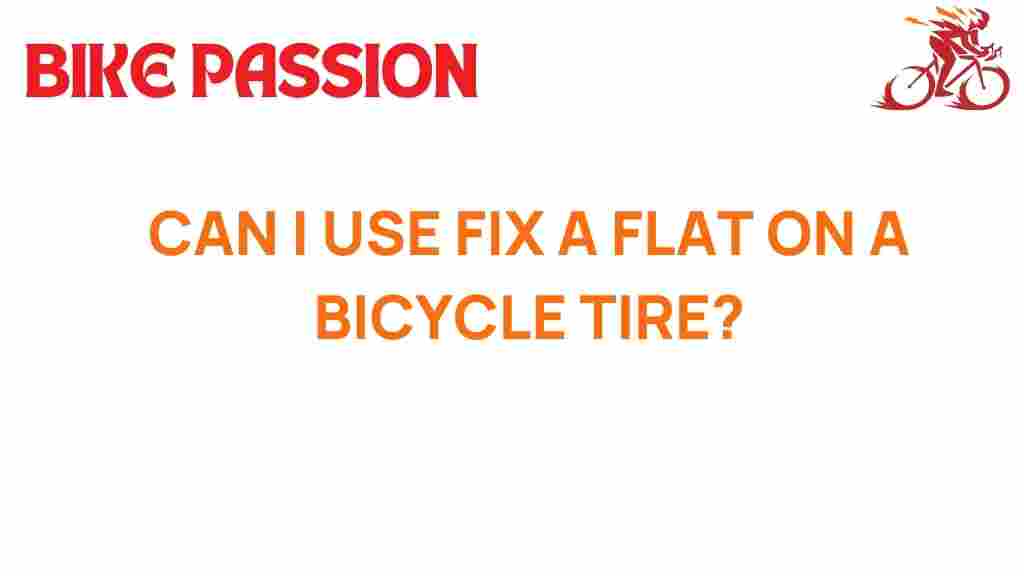Is Fix-a-Flat the Ultimate Solution for Your Bicycle Tire Woes?
Bicycle maintenance is crucial for any cyclist, and one of the most common issues faced by riders is dealing with flat tires. Whether you’re commuting to work or enjoying a leisurely ride on the weekend, a flat tire can be a serious inconvenience. This is where Fix-a-Flat comes into play. But is it truly the ultimate solution for your bicycle tire woes? In this article, we’ll explore everything you need to know about Fix-a-Flat, including its effectiveness, how to use it, and alternatives for tire repair.
Understanding Fix-a-Flat
Fix-a-Flat is an inflation solution designed to temporarily seal punctures in tires. Originally developed for automotive use, it has gained popularity among cyclists for its convenience. When you find yourself with a flat bicycle tire, using Fix-a-Flat can save time and get you back on the road quickly.
How Fix-a-Flat Works
Fix-a-Flat works by filling the tire with a pressurized sealant that coats the inside of the tire. This sealant is designed to plug small punctures as the tire rotates. Here’s a step-by-step process on how to use Fix-a-Flat:
- Identify the Problem: Inspect your bicycle tire to locate the puncture or leak.
- Prepare the Tire: Remove the wheel from the bike and ensure the valve stem is accessible.
- Shake the Can: Before use, shake the can of Fix-a-Flat thoroughly to mix the sealant.
- Attach the Nozzle: Remove the valve cap from the tire and attach the nozzle of the Fix-a-Flat can to the valve stem.
- Inject the Sealant: Press down to release the sealant into the tire. You may hear a hissing sound as the sealant fills the tire.
- Inflate the Tire: Continue pressing until the tire reaches the desired pressure.
- Check for Leaks: Spin the tire and check for any air escaping. If the puncture is sealed, you are good to go!
Advantages of Using Fix-a-Flat
Using Fix-a-Flat has several advantages for cyclists:
- Quick Solution: It allows for a fast and easy fix, getting you back on your bike in no time.
- No Tools Required: Unlike traditional tire repair methods, you don’t need tools or expertise to use it.
- Portable: A can of Fix-a-Flat is compact and can easily fit in your bike bag or pocket.
Limitations of Fix-a-Flat
While Fix-a-Flat can be a lifesaver, it does have its limitations:
- Temporary Fix: It is not a permanent solution. The sealant may eventually degrade, requiring proper tire repair or replacement.
- Not for Large Punctures: Fix-a-Flat is ineffective for large cuts or sidewall damage.
- Possible Mess: The sealant can be messy to work with and may require cleanup.
Puncture Prevention Tips
To minimize flat tires and the need for Fix-a-Flat, consider these cycling tips for puncture prevention:
- Inspect Tires Regularly: Check for wear and tear, cracks, or embedded objects.
- Maintain Proper Inflation: Keep your tires inflated to the recommended pressure to reduce the chance of pinch flats.
- Use Puncture-Resistant Tires: Invest in high-quality tires designed to resist punctures.
- Avoid Hazardous Areas: Steer clear of roads with debris, glass, or sharp objects that can cause punctures.
Other Tire Repair Options
If Fix-a-Flat isn’t suitable for your situation, consider these alternatives for tire repair:
- Puncture Kits: These kits typically include patches and glue for a more permanent fix.
- Inner Tube Replacement: If the puncture is severe, replacing the entire inner tube may be necessary.
- Professional Repair: Visit a bike shop for expert assistance, especially for complex issues.
Troubleshooting Common Issues
When using Fix-a-Flat, you may encounter some common issues. Here are troubleshooting tips:
- Sealant Leaking: If sealant is leaking, check if the puncture is too large for Fix-a-Flat to handle.
- Tire Not Inflating: Ensure the nozzle is properly attached and that the can is not empty.
- Sealant Not Curing: Sometimes, the sealant may take time to harden. Allow the bike to sit in a stable position for a while.
Maintaining Your Bicycle Tires
Proper bike maintenance is essential for prolonging the life of your tires and minimizing the risk of flats. Here are some key maintenance practices:
- Regular Cleaning: Remove dirt and debris from your tires after rides.
- Check Tread Depth: Ensure the tread is sufficient to provide grip and safety.
- Store Properly: When not in use, store your bike in a cool, dry place away from sunlight.
Conclusion
In conclusion, Fix-a-Flat can be a useful temporary solution for your bicycle tire woes, especially when you’re in a hurry or away from home. However, it is not a permanent fix, and cyclists should be aware of its limitations. To ensure a smoother ride, it’s essential to practice good tire maintenance, invest in puncture prevention strategies, and be prepared with a proper tire repair kit. Whether you choose Fix-a-Flat or opt for a more traditional repair method, being informed will help you enjoy your cycling experience to the fullest.
For more tips on bike maintenance, check out our bicycle maintenance guide. And for a detailed look at different types of tire sealants, visit this resource.
This article is in the category Maintenance and created by BikePassion Team
